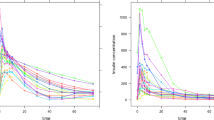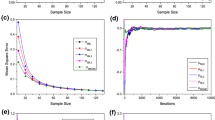Abstract
When models are used to measure or predict physiological variables and parameters in a given individual, the experiments needed are often complex and costly. A valuable solution for improving their cost effectiveness is represented by population models. A widely used population model in insulin secretion studies is the one proposed by Van Cauter et al. (Diabetes 41:368–377, 1992), which determines the parameters of the two compartment model of C-peptide kinetics in a given individual from the knowledge of his/her age, sex, body surface area, and health condition (i.e., normal, obese, diabetic). This population model was identified from the data of a large training set (more than 200 subjects) via a deterministic approach. This approach, while sound in terms of providing a point estimate of C-peptide kinetic parameters in a given individual, does not provide a measure of their precision. In this paper, by employing the same training set of Van Cauter et al., we show that the identification of the population model into a Bayesian framework (by using Markov chain Monte Carlo) allows, at the individual level, the estimation of point values of the C-peptide kinetic parameters together with their precision. A successful application of the methodology is illustrated in the estimation of C-peptide kinetic parameters of seven subjects (not belonging to the training set used for the identification of the population model) for which reference values were available thanks to an independent identification experiment. © 2000 Biomedical Engineering Society.
PAC00: 8715Aa, 0250Ga, 8714-g
Similar content being viewed by others
REFERENCES
Allen, D. G., B. R. Jewell, and E. H. Wood. Studies of the contractility of mammalian myocardium at low rates of stimulation. J. Physiol. (London) 254:1–17, 1974.
Blinks, J. R. and J. Koch-Weser. Analysis of the effects of changes in rate and rhythm upon cardiac contractility. J. Pharm. Exptl. Ther. 139:373, 1961.
Kaveler, F. Membrane Depolarization as a cause of tension development in mammalian ventricular muscle. Am. J. Physiol. 197:968, 1969.
Niggli, E. Localized intracellular calcium signaling in muscle calcium sparks and calcium quarks. Annu. Rev. Physiol. 61:311–335, 1999.
Winslow, R. L., J. Rice, S. Jafri, E. Marba´n, and B. O'Rourke. Mechanisms of altered excitation–contraction coupling in canine tachycardia-induced heart failure, II: Model studies. Circ. Res. 84:571–586, 1999.
Wood, E. H. and G. K. Moe. Measurement of edema in the heart-lung preparation. Am. J. Physiol. 136:506–514, 1942.
Wood, E. H. and G. K. Moe. Electrolyte and water content of the ventricular musculature in the heart-lung preparation with special reference to the effects of cardiac glycosides. Am. J. Physiol. 136:515–522, 1942.
Wood, E. H. and G. K. Moe. Blood electrolyte changes in the heart-lung preparation with special reference to the effects of cardiac glycosides. Am. J. Physiol. 137:6–21, 1942.
Wood, E. H. Special instrumentation problems encountered in physiological research concerning the heart, lungs and circulation in man. Science 112:705–715, 1950.
Wood, E. H. Evolution of instrumentation and techniques for the study of cardiovascular dynamics from the thirties to 1980. Alza lecture. Ann. Biomed. Eng. 6:250–309, 1978.
Wood, E. H., R. L. Heppner, and S. Weidmann. Inotropic effects of electric currents. Circ. Res. 24:409–445, 1969.
Wood, E. H., D. G. Allen, and B. R. Jewell. Preponderance of postsystolic period in the positive inotropic effects of increases in @Ca11#o. In: Recent advances in studies on cardiac structure and metabolism, edited by P. E. Roy and P. Harris. Baltimore: University Park, 1975, Vol. 8.
Wood, E. H. New vistas for study of the structural and functional dynamics of the heart, lungs, and circulation by noninvasive numerical tomographic vivisection. Circulation 506:506–520, 1977.
Wood, E. H. Noninvasive vivisection. Mayo Clin. Proc. 53:59–60, 1978.
Author information
Authors and Affiliations
Rights and permissions
About this article
Cite this article
Magni, P., Bellazzi, R., Sparacino, G. et al. Bayesian Identification of a Population Compartmental Model of C-Peptide Kinetics. Annals of Biomedical Engineering 28, 812–823 (2000). https://doi.org/10.1114/1.1289459
Issue Date:
DOI: https://doi.org/10.1114/1.1289459




